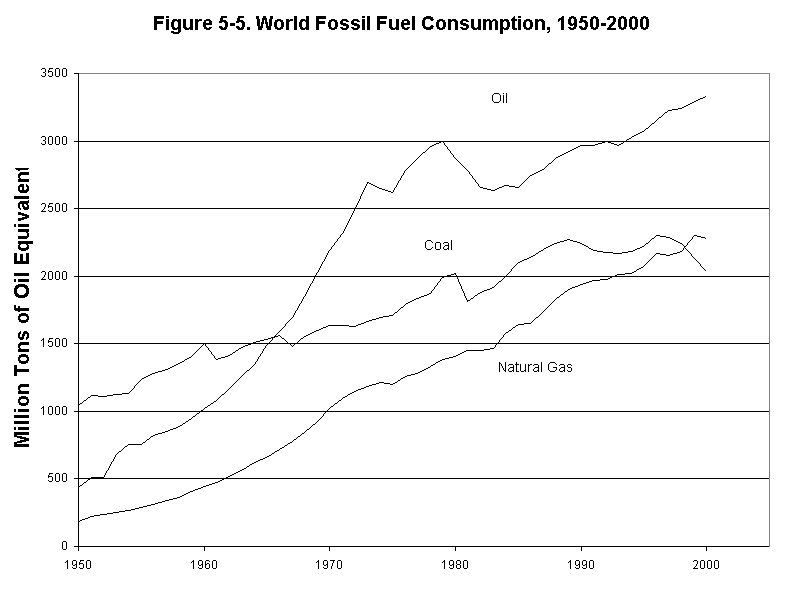"Eliminating water shortages depends on a global attempt to raise water productivity similar to the effort launched a half-century ago to raise land productivity, an initiative that has nearly tripled the world grain yield per hectare." –Lester R. Brown, World Facing Huge New Challenge on Food Front in Plan B 3.0: Mobilizing to Save Civilization
Chapter 5. Building the Solar/Hydrogen Economy: Natural Gas: The Transition Fuel
Over the last half-century, the use of natural gas has increased 12-fold. Indeed, in 1999 natural gas eclipsed coal as a world source of energy, making it second only to oil. (See Figure 5-5.) This growth in natural gas use is fortuitous, because as this energy source grows, the storage and distribution system—whether long-distance pipelines or the detailed distribution networks within cities that supply natural gas to individual residences—is also expanding, setting the stage for the eventual switch to a hydrogen economy.53
Natural gas could overtake oil as the world's leading source of energy within the next 20 years, particularly if an anticipated downturn in oil production comes in this decade rather than the next. Natural gas has gained in popularity both because it is a clean-burning source of energy and because it is less carbon-intensive than either coal or oil. It emits scarcely half as much carbon as coal does for each unit of energy produced. In contrast to both coal and oil, which often emit sulfur dioxide and nitrous oxides when burned, gas burns cleanly.54
It is this clean-burning quality that has appealed to governments as a way of reducing air pollution. In China, for example, shifting from coal to natural gas for both industrial and residential uses is reducing the urban air pollution that has claimed literally millions of lives in recent years. As part of its long-term planning, China is building a new pipeline from gas fields discovered in its far northwest to the city of Lanzhou in Gansu Province. The government has also approved the import of natural gas and is now planning to build a pipeline linking Russia's Siberian gas fields with Beijing and Tianjin, both leading industrial cities.55
Natural gas's potential to play a central role in the transition from the fossil fuel era to the solar/hydrogen era has not escaped the more progressive leaders in this industry. For example, Gasunie, the Netherlands natural gas utility, expects to be a major player in this transition. Although Gasunie now transports natural gas from the North Sea gas fields across the Netherlands to other countries in Europe, the firm plans eventually to use offshore wind power to generate electricity, converting it into hydrogen that will then be moved through the pipeline system now used for natural gas.56
In the United States, Enron, a Texas-based natural gas company that in recent years has become a global energy company, is also keenly aware of the part it can play in the transition to the new energy economy. In recent years, it has purchased two wind companies, which gives it the capacity to exploit the vast wind resources of Texas. This abundance of wind to generate cheap electricity and produce hydrogen gives Enron the option of one day feeding the hydrogen into the same distribution network of pipelines that it now uses to distribute natural gas in the Northeast and Midwest.57
A similar situation exists in China, where the development of natural gas fields in the northwest and the pipelines used to carry the gas eastward to industrial cities could one day be used to carry hydrogen produced with the region's wealth of wind resources. (The installation of wind turbines along with the more traditional windbreaks of trees in areas where soil is vulnerable to wind erosion could also help control erosion and the dust storms that blow across the country to Beijing and other cities.)
Natural gas companies are well positioned to be leaders in building the solar/hydrogen economy. They may someday invest in wind electric generation in remote regions that have a wealth of wind, and then use that electricity to electrolyze water and produce hydrogen. This could then be exported in liquid form, much as natural gas is now compressed into liquid form for shipping in tankers.

ENDNOTES:
53. Figure 5-5 from Dunn, op. cit. note 4.
54. Gregg Marland, "Carbon Dioxide Emissions Rates for Conventional and Synthetic Fuels," Energy, vol. 8, no. 12 (1983); DOE, EIA, Impacts of the Kyoto Protocol on US Energy Markets and Economic Activity (Washington, DC: October 1998), p. 95.
55. EIA, "Country Analysis Brief: China" (Washington, DC: DOE, April 2001), www.eia.doe.gov/emeu/cabs/china.html.
56. Lester R. Brown and Christopher Flavin, "A New Economy for a New Century," in Lester R. Brown et al., State of the World 1999 (New York: W.W. Norton & Company, 1999), p. 17.
57. Enron purchases of solar companies (Zond in the United States and Tacke in Germany) from AWEA and from Enron Wind, "Enron Forms Enron Renewable Energy Corp.," press release (Houston, TX: 6 January 1997).
Copyright © 2001 Earth Policy Institute

